Celebrating the passion, dedication and personal stories of Social Ecology faculty, staff, students, alumni and benefactors, “The Dean Asks…” is a feature in which Dean Valerie Jenness interviews people inspired by the pursuit of excellence and encourages participation in interdisciplinary education to solve complex societal problems. Over the next year, please check back to read or listen to additional installments. View Archive
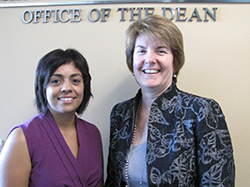 Valerie Jenness, Dean of the School of Social Ecology, interviews Assistant Professor Maria Rendón about her research on second generation immigrants and urban inequality. Rendón is currently working on a book called "Second Generation Optimism and the Reproduction of Mexican Working Class,” which looks at the class mobility and assimilation of second generation young Latino men in Los Angeles.
Valerie Jenness, Dean of the School of Social Ecology, interviews Assistant Professor Maria Rendón about her research on second generation immigrants and urban inequality. Rendón is currently working on a book called "Second Generation Optimism and the Reproduction of Mexican Working Class,” which looks at the class mobility and assimilation of second generation young Latino men in Los Angeles.
Val: You are working on a book called “Second Generation Optimism and the Reproduction of Mexican Working Class”. Tell us about your book.
Maria: This study initially started to try to understand how Latino young men were being incorporated into the United States, particularly Latino young men growing up in the inner city. A lot of immigration scholars have been suggesting for quite some time that certain immigrant groups are struggling more than others and that Latino young men, specifically children of Mexican immigrants, are having a really hard time moving up. They are not experiencing traditional assimilation that other immigrant groups experience. I have always been interested in urban neighborhoods—why they matter and how they influence a number of life outcomes. Therefore, the book began as a study of how the neighborhood context matters in shaping the social mobility trajectories of Latino young men.
In 2007 when I first started interviewing young inner city Latino men, it was for my Ph.D dissertation. But when it was time to transform it into a book, we were in the biggest recession since the Great Depression. Jobs were disappearing and unemployment was on the rise. Therefore, I could not write this book without taking a look at the larger economic context and how it was impacting these Latino young men and their families. Latinos were particularly affected by the recession. Recent data shows that Latinos lost about 60 percent of their wealth during the recession.
Fortunately, the Stanford Center for Poverty and Inequality funded me to go back to the young men I originally interviewed in 2007 to see how they have navigated this recession. I am currently in the thick of the interviews. I am learning quite a lot in terms of the strategies these families—Latino young men and their immigrant families. I say this as families because most of these young men are still living with their parents at age 25 to 27 years old. Most of them are living in the same neighborhoods. Only in a couple cases, are they actually living in what you would call a nicer or better off neighborhood.
Val: When we recruited you to UCI, we hoped that you could help our School elevate our thinking along broad lines of race, ethnicity, urban space, and inequality. At the macro level, is there anything else about this Latino population that situates them differently? What else should we know about this group at the aggregate level?
Maria: There is a lot of concern in regards to their mobility trajectory. I think we should all be concerned about what's happening to this group because over 50 percent of students who graduate from high school in the state of California are Latino. Most of them are second generation children of immigrants. For a long time we have been paying attention to immigrants, but the growth of the Latino population is now driven by the second generation. They are becoming a huge portion of the American labor force. One in four young adults in their 20s is Latino. One in four adults is an immigrant or children of immigrants. The American labor force is shrinking because many of the baby boomers are retiring. I believe three quarters of the growth in the next 10 years are going to be Latinos. Therefore, how this group of people fares is incredibly important.
Val: For me, this situation really makes your research much grander than just a study of a couple neighborhoods. Tell us about how you chose to study these neighborhoods and why these young men. What do they represent for you?
Maria: I am inspired to study this topic because we don’t know enough about it and I found that the current theories on this topic don’t fit my own experiences.
I am a sociologist by training and I would consider myself not only an immigration scholar, but also an urban sociologist. Urban poverty literature has focused historically on the experience of poor African Americans for very important reasons. African Americans still experience the highest rates of poverty concentration and segregation in the United States. However, in places like California, Latinos experience similar levels of residential and labor market segregation. They are the most segregated group in Southern California, but there has been a lack of research on this group.
Another reason I am studying this population is because I was unsatisfied with some of the literature and theories of urban life. I come from a very similar background, a poor working class neighborhood. Some of the literature I read just didn’t resonate with what I witnessed or experienced. So I decided to go back to these neighborhoods, now with the new tools that I have acquired in college, and ask very important questions about how the urban neighborhood context matters and how it is shaping or constraining social mobility.
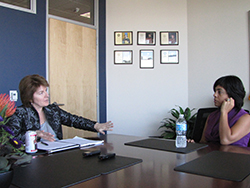 Val: Tell us about the two neighborhoods that are the empirical anchoring point for your book and the years of data collection you have done.
Val: Tell us about the two neighborhoods that are the empirical anchoring point for your book and the years of data collection you have done.
Maria: I studied two disadvantaged neighborhoods in Los Angeles where about 30 - 40 percent of individuals in these neighborhoods live in poverty.
Some immigration theories suggest that what really matters and is driving downward assimilation for this group is the racial demographic of the neighborhood. There is a concept of “segmented simulation framework,” which suggests that exposure to the inner city is detrimental because immigrants are exposed to native born minorities who have an oppositional cultural outlook. From this point of view, these native born minorities in the inner city live different lifestyles—not mainstream—and the new immigrant generation picks up on these negative oppositional outlooks. I wasn’t quite convinced this was a mechanism contributing to a lot of inner city problems, such as high school dropout rates. So I picked these two neighborhoods. They were similar in terms of poverty rates, but one neighborhood context was high in immigrants and the other was almost 50% native born African Americans and 50% Latino immigrants. I did this to test this theory, which would predict different types of acculturation processes across these neighborhoods. My goal was to really understand what it is like to grow up in an immigrant neighborhood versus an African America/Latino neighborhood. How does it shape your world-views, decisions and how you think culturally in terms of school and work?
Val: What were your research methods?
Maria: I'm most interested in the experience of Latino young men because it is the case across many racial ethnic groups that young women are doing better in school. The Latino male high school dropout rate is higher than Latinas and more Latinas are going to college. There is something going on with young Latino men. According to the literature, young men are more exposed to the neighborhood context whereas young females are often protected a bit more. So I decided to interview young men and their immigrant families and to really try to understand how the neighborhood context mattered. We are in a time with Facebook and people are communicating across space in various ways. Our world is much more connected, which raises the question –do neighborhoods matter? Do local neighborhoods impact our life?
As a graduate student at Harvard, I did my first wave of data collection. The families were very supportive of my work. They wanted to help out a student. I was an outsider, but also an insider because I am Latina. Also, I think there was a lot of hope that I would tell their story. I had really in depth conversations with these young men and it was quite interesting. They often shared more than I expected and they welcomed someone finally asking them what it was like to grow up in these neighborhoods. Even though I grew up in a similar neighborhood, I didn’t realize how much violence mattered in the day to day lives of young men. Violence matters for females too, but it matters in a different ways for young men. Los Angeles is known as the gang capital of the world. The majority of young people I interviewed in these neighborhoods are not gang members, yet they have to navigate and live in a context where gangs matter.
Val: One of the things that I think comes out so well in your book chapter I read is the way in which the mere presence or threat of violence has its own structuring consequence—such as how I walk to school, where I go, who I ally myself with, and peer networks. The part that really captured my attention was even when I'm "out of the mix" the mix has structuring processes working on me. It's consequential for how I organize my life.
Maria: Some young men were buffered from gangs by parents and schools. So it is important to think about this as well. Not all inner city youth are exposed equally to violence and equally to the neighborhood. But among those who are, they have to figure out how to live in the neighborhood. They rely on peers quite a lot, which has certain obligations. Next time their peer is in a fight, they are going to feel compelled to support and back him up. It is a norm of reciprocity. But this has consequences, such as getting expelled from school, which in turn makes it difficult to complete high school.
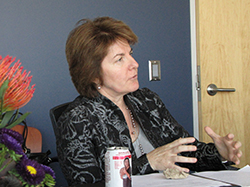 Val: Also in your book, you describe “buffering” processes, which include athletic programs, bussing out to other schools, and father figures. So these buffering processes are a kind of micro management of an environment that resituates someone—not in physical space of the neighborhood, but in interactional space.
Val: Also in your book, you describe “buffering” processes, which include athletic programs, bussing out to other schools, and father figures. So these buffering processes are a kind of micro management of an environment that resituates someone—not in physical space of the neighborhood, but in interactional space.
Maria: That’s right. When you look at who graduates from high school from these neighborhoods, you see that their social peer networks have been structured differently. Some of the young Latino men I interviewed were bussed out of the neighborhood, so they were not exposed to the neighborhood context to the same degree as others. This created a different social world even in this neighborhood.
Val: It's interesting to me because the mechanisms to lift or “buffer” people out of a neighborhood leaves a different population behind. The neighborhood has then been reconfigured. Does this have a consequence on economic and social mobility?
Maria: Yes. I see the neighborhood context having a real impact on mobility. The kids who don’t have the buffers are much more vulnerable. That is why five years after my original interviews, I am currently going back to these young men to see how they are faring. I would like to ask the pressing question: how does the neighborhood context matter and how does it impact everybody, not just the young men? What are the collateral consequences?
Val: I gather from your work that you reject the mechanism of oppositional culture that has been present in urban poverty literature. What is the mechanism that you are positioning?
Maria: Well in terms of the opposition of culture, one of the pieces to this is the idea that pessimism exists among certain segments of the population. It is believed that the poor have a perception of a blocked opportunity structure in the United States. I found that this is completely the opposite. It is one of the most shocking things I found. Even now after the recession, I would expect pessimism or the perception of blocked opportunity. However, I found five years later, these young men are incredibly optimistic. The current research literate does not capture this.
Val: Would you go as far as to say they buy the American dream?
Maria: Absolutely. They believe that it is a going to work if they work hard. For example, they see that their undocumented immigrant dad was able to purchase a house in the neighborhood, so they think that they should be able to achieve that and more. They know English and believe that they have more opportunities than their parents. That’s the American Dream. They talked this way five years ago and they are still talking this way today, despite the recession and their setbacks. It does not shake their optimism. Based on my studies, they are very much believers of the American Dream.
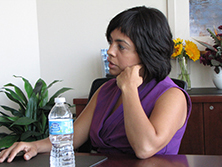 Val: When I read your book chapter, I was reminded of studies that I used to read in graduate school that would survey different classes of people and ask them about what they value for themselves and their children. All classes value education for their children.
Val: When I read your book chapter, I was reminded of studies that I used to read in graduate school that would survey different classes of people and ask them about what they value for themselves and their children. All classes value education for their children.
Maria: Right. The young men I interviewed could go on and on about how and why education matters even though they dropped out. Their conventional values are there. However they live in a very particular environment where they have to make decisions on how to navigate the neighborhood context. I think we do need to look at behavior and understand why individuals behave the way they do. How does the context shape their behavior? That is what I'm trying to research.
Val: When you read aggregate levels findings on issues such as dropout rates or imprisonment, to me those are the byproducts of social structure. But I don’t think most people in the neighborhoods you study think structurally, which helps them maintain their optimism.
Maria: Right. For example, when I interview the young men, I ask about discrimination. A lot of them will say well it exists but they personally haven’t experienced it. Yet in the next sentence they talk about police brutality or give another story about discrimination. This is why interviews are really important. They help us learn what influences and shapes the individual's perspectives, motivates them, and drives them. The way they understand their world is different than the way an academic understands their world. However, it is our job as academics to look at structural factors that actually keep some of these young men living in these neighborhoods and staying in poverty across generations. So that is where I currently find myself in my research. I am learning a lot about the ways in which families are relying on one another to get by or ahead. This is great in terms of resiliency; however, it also highlights how taxing and limiting it can be on families.
Val: I know this wasn’t meant to be a policy book, but can you tell us what the policy implications may be, based on your findings?
Maria: Families are relying on one another to get by and to get ahead. They are drawing on their social networks. For example, these young men are relying on a sister who told them about the job, or a cousin who helped them with their college application. But their social networks are also either in poverty, lack information or are trying to get by as well. There is a limit to how much the poor can help one another. I hope my interviews will help shed light on why we need a stronger safety net.
Val: You also recommend contributing to enhance the buffering strategies you previous spoke about.
Maria: Some people have read this chapter and have the impression that I am suggesting that we remove them and leave these communities as they are. But many of the young men I interviewed were not removed by buffering strategies. They may not have been in the mix in terms of violence and crime, but they are still very much in the neighborhoods. Therefore we need to invest in the extra-curricular activities in these neighborhoods.
Val: If there was one thing you wanted people to take away from your work, what would it be?
Maria: I would say that it is time that we tap into the optimism and motivation of these inner city young men. We often question their motivation and garner the resources that they need in order to position themselves in a better direction. But at least in my interviews, the young men, including the high school dropouts, are incredibly optimistic and motivated. They have the energy and drive to do well. I think that is a lost resource at times. We question where is America heading and I think there's a lot of hope and potential if we address some of these really important issues, like the dropout rate and class and racial segregation. I hope that my book allows us to figure out policies that will redirect the energy of these young men in a more constructive way.
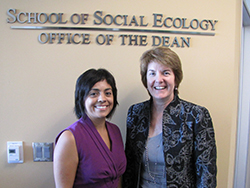 Val: You went to UC Irvine as an undergraduate, then Harvard for graduate school. Now you are back at UC Irvine in your second year in the Department of Planning, Policy and Design and an appointment the Department of Sociology. What does coming back to UC Irvine mean to you and contribute to your research?
Val: You went to UC Irvine as an undergraduate, then Harvard for graduate school. Now you are back at UC Irvine in your second year in the Department of Planning, Policy and Design and an appointment the Department of Sociology. What does coming back to UC Irvine mean to you and contribute to your research?
Maria: First, coming back to Southern California puts me closer to the communities I study. I am a product of urban schools or the urban environment. I still recall the L.A. riots when I was in eighth grade. Many of the businesses in my community burnt down and this had a huge impact. It really started making me wonder and think about the urban context in cities. At UC Irvine, I really would like to continue doing work that highlights and uncovers how the neighborhood context matters in the opportunities or lack of opportunities for young men. I think faculty in the Department of Planning, Policy and Design really do care about the policy and planning implications of their research. Therefore, I think it is a good place for me.
Val: What else would you like to tell us about you?
Maria: As a faculty member, I care very much about students and I have a soft spot for the first generation students because I was a first generation college student. I hope to be a role model to them because students have a lot to learn. So many students come, sit in the back of the class and then leave, banking on the idea that a B.A. is going to give them that nice middle class job. But that is not the case anymore. People graduating from college are struggling to find a job in this economy. I hope I can encourage students to seek out internships, establish ties with faculty members and get to know the communities that they are trying to change and impact. It's not only about the books, but it is really stepping out and working with these communities or career fields they are interested in. I think Social Ecology tries to encourage students to get hands on experience and does this well. That is why I feel at home in the School of Social Ecology, in particular the Department of Planning, Policy and Design. When I was an undergraduate student, UC Irvine was a great institution for me because I was well connected to my peers through organizations and with faculty that took me under their wings. I hope I can do the same for students while I am here.